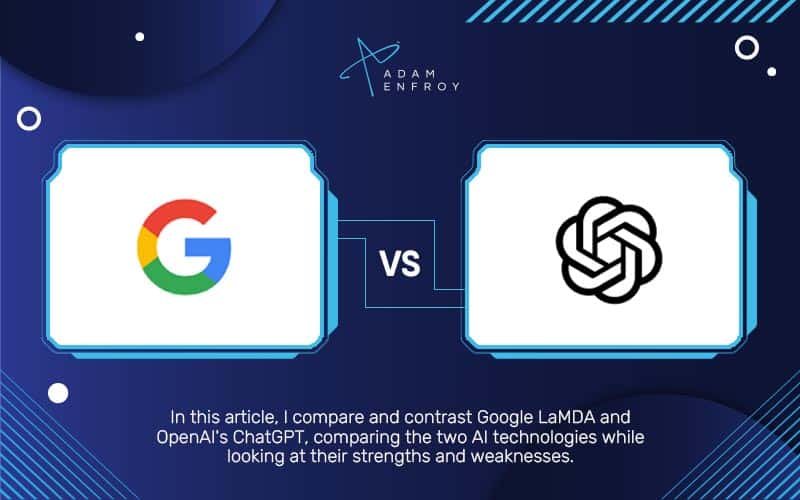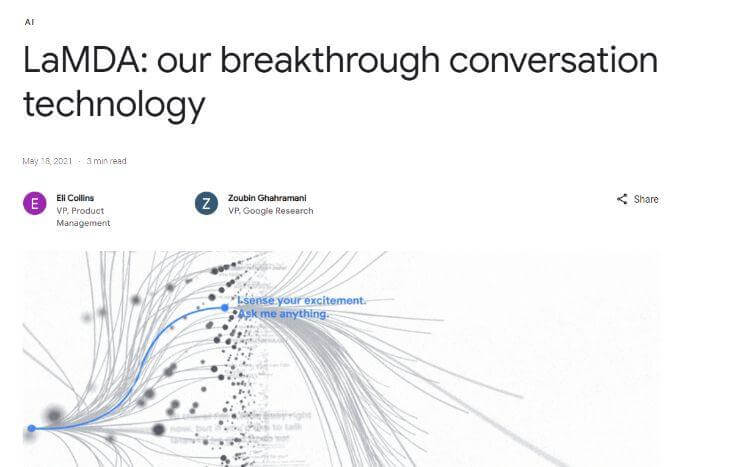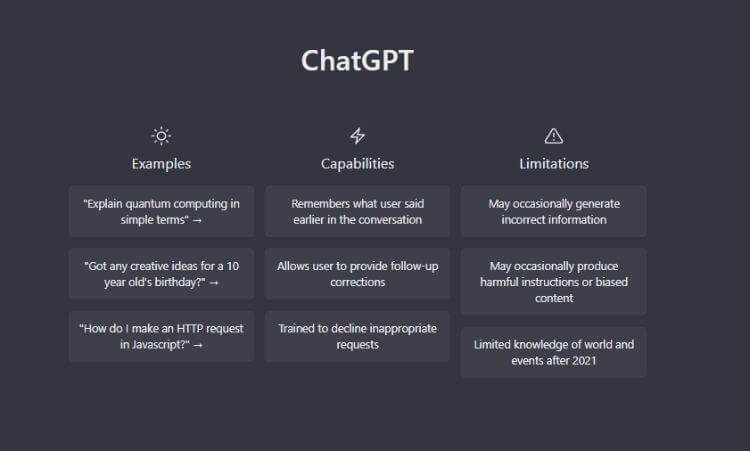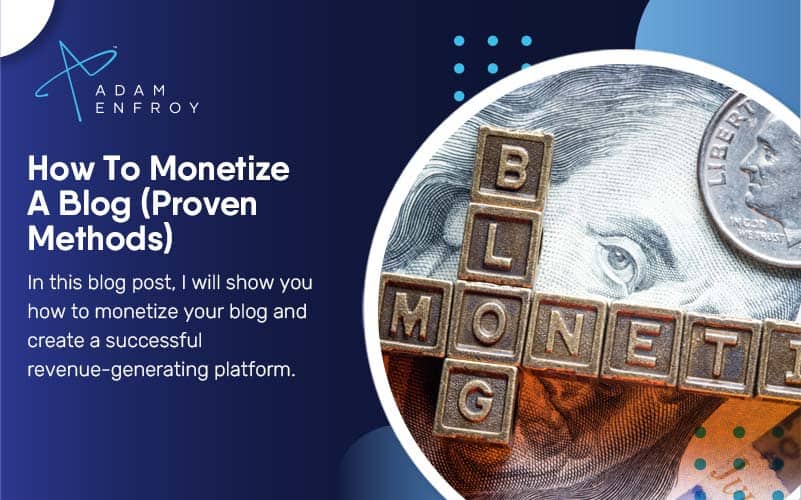LaMDA vs. ChatGPT: Similarities & Differences Of Each AI (2024)

As AI technology continues to evolve and improve, many companies are looking for ways to create more engaging and conversational AI experiences.
Two of the most popular tools in this area are LaMDA and ChatGPT.
LaMDA is a proprietary AI technology that combines natural language processing with deep learning algorithms to enable an AI system to understand and respond to user input more humanly.
ChatGPT, on the other hand, is an AI technology developed by OpenAI.
Unlike LaMDA, ChatGPT does not require any programming or configuration.
Instead, it uses a combination of natural language processing and an advanced AI system to generate responses based on user input automatically.
ChatGPT is particularly useful for creating more personalized and interactive conversations with users.
In this article, I’ll compare and contrast the two technologies, looking at their strengths and weaknesses.
I’ll also look at how one might use them for different projects.
Google LaMDA – The AI of the Future?

At its core, LaMDA does not rely on heavily curated datasets or scripted dialogs.
Instead, it uses deep learning, advanced natural language understanding, and semantic search technology to understand the discussed topics and produce generated responses.
Natural language processing models are increasing in sophistication and capability every day.
Its design focuses on quality, safety, and groundedness – making it stand out from other models.
Thanks to its seamless integration with Google programs like Workspace and Assistant, as well as their Google search engine, LaMDA is at the forefront of AI technology.
The primary way LaMDA stands out from other natural language processing models is its focus on quality, safety, and groundedness, allowing for a more authentic experience when interacting with this AI.
Quality refers to how well the model can generate responses based on freely accessible conversation data, in which LaMDA excels due to its large number of parameters.
Safety refers to how well the model understands nuanced contexts in conversations.
In this area, LaMDA also excels due to its inclusion of additional training data that allows for greater accuracy in understanding context.
Lastly, groundedness refers to how well the model can ground conversations in actual knowledge about the world.
Experts have praised LaMDA for its ability to make connections between topics based on real-world information rather than just memorizing phrases or keywords.
Developers can create applications utilizing LaMDA’s natural language processing capabilities without worrying about compatibility issues or compatibility issues.
Startups and veteran businesses can use their existing data sets when training their AI systems with this model.
They save time and money while taking advantage of all this model offers.
What is ChatGPT?

ChatGPT stands for Conversational Generative Pre-trained Transformer.
It is an AI-based NLP model that uses text and audio input to generate a response.
OpenAI, a research lab dedicated to advancing artificial intelligence (AI), created this model.
ChatGPT stands out from other models due to its ability to generate responses based on natural language input.
It is a conversational AI platform that uses the latest everyday technology to generate responses to user queries.
The platform excels in specificity regarding generating realistic conversations and understanding context.
Built upon recent advancements in natural language processing, it can understand the intent of a user’s query and context.
Developers and businesses can easily customize the output of AI chatbots to their specific needs, allowing them greater control over the conversations generated.
How Does ChatGPT Work?
ChatGPT works similarly to other AI models but differs in that it uses reinforcement learning techniques and human AI trainers to monitor quality control and make corrections when necessary.
The model learns more quickly than traditional models since it can access feedback from real people familiar with the task.
The model also uses GPT-3.5 architecture capable of understanding natural language and recognizing patterns in speech and writing styles.
Finally, ChatGPT can generate more accurate responses than those caused by other NLP models.
Microsoft’s Plans for Bing Search Engine Integration
Microsoft recently announced the plan for a strategic partnership with AI developers from OpenAI.
With a potential investment of millions of dollars, Microsoft would leverage the large language model to integrate the technology into its Bing search engine.
As a direct competitor to Google, Microsoft seeks to give users a more personalized search experience.
Additionally, Bing would focus more on integrated machine learning capabilities, improving its accuracy over time.
All these features make Bing an ideal choice for businesses leveraging AI technology in their operations.
The Benefits of ChatGPT
As users demand businesses meet their customer service needs in seconds, ChatGPT can provide a valuable solution.
ChatGPT can quickly and accurately respond to user queries with human feedback and reinforcement learning.
As a result, it can provide better customer support and be an all-encompassing AI chatbot for businesses.
The flexibility of ChatGPT also enables it to be one of the most exciting technologies of the moment.
With users continuing to demand ever more personalized conversations and interaction, the AI research is ever-growing.
In addition, ChatGPT also comes with a range of tools and features that one can use to customize the platform.
ChatGPT also offers reinforcement learning through reward-based training from the text Da Vinci 003 model.
Despite inaccuracy with its output, the AI can learn after it makes mistakes by teaching itself how to tackle specific tasks over time.
In addition, this advanced framework also can customize responses for each user based on their individual preferences or needs as it gathers data from previous interactions with them.
Comparing LaMDA and ChatGPT: What is the Difference?
Here are some of the key differences between these two platforms.
Data Sets
The base model of LaMDA and ChatGPT is formed from large datasets containing billions of words and data.
Developers trained LaMDA on a dataset called Transformer, a neural network architecture that Google Research invented.
LaMDA’s growth is measured by collecting answers from their pre-trained model, fine-tuned model, and human raters to multi-turn two-author dialogue.
Humans and machines evaluate this data based on various questions against specific metrics.
Google engineer teams working on LaMDA have been focusing on an artificial intelligence algorithm that can generate more personalized and accurate responses.
On the other hand, ChatGPT uses a dataset called GPT-3.5 (the successor of GPT3 and the predecessor of GPT-4), an AI language model developed by OpenAI.
ChatGPT contains as many as 175 billion parameters.
These parameters offer a more extensive range of data sets that one can use to train the model for both the user and the researcher.
When it comes to dialogue data, ChatGPT offers access to a large number of datasets from its training sources.
ChatGPT – Natural Language Understanding
Natural language understanding is a data science technique used to understand the meaning of a sentence.
ChatGPT is a neural language model that uses extensive data collection for training its model.
The system can better understand complex natural language queries and generate more accurate responses.
LaMDA – Question Answering Platform
As a “Language Modeling from Dialogues Actively,” LaMDA’s question-answering platform provides a comprehensive set of interactive question-and-answer capabilities.
LaMDA’s NLU conversational technology uses human raters to ascertain the accuracy of the response, while ChatGPT, on the other hand, utilizes deep learning algorithms.
From understanding natural language queries and categorizing them, LaMDA’s responses can handle many customer service and marketing automation tasks.
As a result, LaMDA is revolutionizing the general public’s ability to interact and converse with machines.
Unlike traditional Google and other search engines, LaMDA can have a two-way conversation.
The platform can provide users with answers based on their questions and help them understand the context.
Moreover, with platforms such as Amazon offering similar functions that can help improve LaMDA, the future looks bright for this AI.
Moreover, with multiple iterations of an AI test kitchen set up to get user feedback, LaMDA can improve with each iteration.
What Is Supervised Learning?
Supervised learning is the process of using an input text or data set to train an AI system.
One can use such learning in various applications, including deep learning, machine learning software, and computer vision.
With a deep learning framework like text-DaVinci-002 and the aforementioned text-DaVinci-003, developers can train the AI on any number of tasks.
One practical example of developers using supervised learning is hate speech detection.
The AI can recognize similar language and respond accordingly by training a model on hate speech text.
When code red flags are in place, AI can become a valuable tool to identify and stop human speech that many consider hateful before it spreads.
LaMDA vs ChatGPT – FAQ
Who Are Some Key People In The Current AI Revolution?
Sundar Pichai, CEO of Google, is an important figure in advancing AI.
He has been at the forefront of Google’s AI initiatives, including their use of machine learning and deep-learning models.
OpenAI co-founder Sam Altman also leads the AI revolution, leading his team to develop numerous deep-learning models.
Does Artificial Intelligence Have Emotions?
As the lines between humans and AI become blurred, the debate over artificial intelligence having emotions has arisen.
Some experts believe that AI can exhibit emotions, while others argue that AI cannot feel emotions like humans.
In 2022, former Google engineer Blake Lemoine was dismissed after he made known his hypothesis, claiming that the tech giant’s language-processing systems are sentient and should thus have their wishes honored.
How Does Social Media Use Artificial Intelligence?
Social media platforms use AI to analyze user behavior and suggest content they may be interested in.
AI is used to track online conversations, understand the sentiment and detect hate speech. AI can also create personalized user recommendations based on past interactions or what their peers have liked.
What Does Sensibleness Refer To In AI?
Sensibleness refers to the ability of a natural language processing (NLP) system to understand and respond accurately to an input query.
Sensibility is measured using human ratings and accuracy on specific tasks, such as sentiment analysis.
For subscribers to LaMDA’s natural language processing services, sensibleness powers their AI-driven conversation.
Wrap Up.
Artificial intelligence is an integral part of many businesses today.
With a fine-tuned model, Google AI can power customer service applications and natural language processing.
The LaMDA AI platform provides a powerful language model for dialog applications as a pre-trained model.
On the other hand, OpenAI’s ChatGPT can monitor conversations in real-time and provide more personalized responses.
Keeping an eye out for advances in AI technology is essential.
As a result, businesses can provide better customer service experiences and save time and money in the long run.
Businesses can also stay ahead of the curve and ensure their customers have an optimal experience with their products and services.
Further reading on AdamEnfroy.com: Businesses are using artificial intelligence in various applications.
- AI writing software tools can help businesses create content quickly and accurately.
- AI video generators can create unique and engaging videos for businesses.
- AI image generators can help businesses with marketing and designing images.
- AI voice generators can help enterprises to develop natural-sounding responses to customer queries.
- AI chatbot platforms can help companies to provide customer service.
By utilizing the newest AI technologies, businesses can improve their processes and remain competitive in their respective industries.





